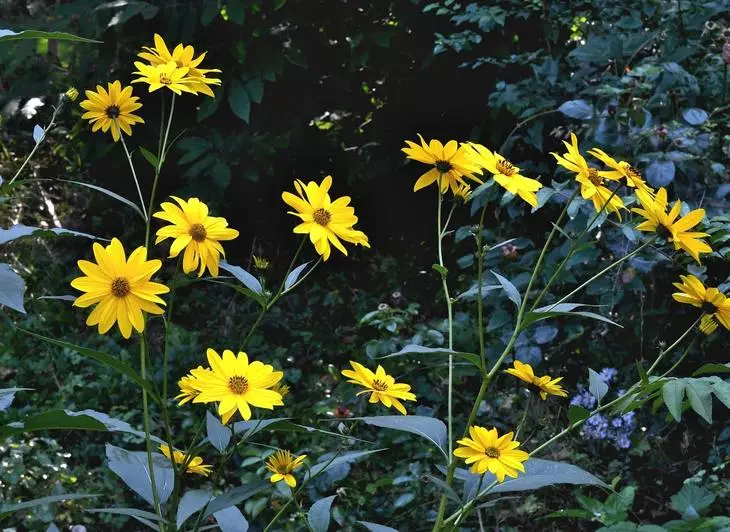
Thanks to the scientist, today we know much more about the healing and as a whole useful properties of the Topinambur than before. Eat Topinambe more often, and you will get the most important trace elements. Tubers are rich in iron, which gives energy, as well as potassium and vitamin B1, supporting your muscles and nerves in order. Although the tubers of the Topinambur sweet, their starchy fiber stops any jumps of blood sugar levels - they have a lower glycemic index than in potatoes, therefore they are not fulfilled from the Topinambura, and it is recommended for diabetes.
Topinambur (Botanical name Helianthus tuberosus) is one of the favorites of organic farming. Demonstrating the striking resistance to diseases, he famously displaces any competitors, including the notorious dangerous Borshevik Sosnovsky, enriching the soil by the Organic. In essence, Topinambur does not need pesticides or fertilizers. The efforts of breeders have created varieties of both white and red tubers.
How to grow Topinambourism and not get to him
The super-ability of the "solar fishing rod" to survival was the reason for the prejudices of the gardeners. It would seem that Topinambur would be very simple by analogy with potatoes. Is that the "sunny fishing rod" can be planted not only in early spring, but also in autumn to the freezing of the Earth.
Like potatoes, plant either with a whole tuber, or cut into pieces with sprouted "eyes", and put in the soil to a depth of 10 (with a spring landing) to 15 cm under the winter, observing the distance of 40-50 cm, since the plants are high , And for the production of tubers, recurrence plays in minus.
Now about the main thing. "Solar fishing rods" will grow and multiply from the smallest piece left in the ground. So, when landing the Topinambur, the dacha will have to take precautions.
Use the raised bed with a bottom of the wire mesh. The grid mesh will not give plants to scatter on the site and damage to other cultures. A simple raised garden of Topinambur will not hold. To climb the garden and do not have to worry about watering even in a dry summer.
Despite the fact that the Topinamburus will need support, a good solution will organize such a reinforced bed next to the fence. Thus, you will also receive protection from a curious look plus a beautiful landscape design.
Topinambur blooms effectively at the end of summer, and after the frosts come, cut the stems up to 50 cm and wait until the tubers in the ground grabbing with frost. They will become more sugar and they will be easier to absorb the body.
Unlike potatoes, Topinambur can not be kept for a long time at least about 10 days in a cold room in a box with sand. But you can leave them in bed to early spring, if necessary, digging for a pitch.
How to cook TopinamburWe must admit that the cleaning of the Topinambura is still a pleasure. As a rule, it turns out too much cropping, but considering how trouble-free and cheap at the cost of the garden, these organic tubers are, with such a disadvantage you can accept.
Alternatively, start cleaning after cooking. In the case when you cleared the fresh Topinamburg, place the tangles in a bowl with acidic water (cold water with a small amount of lemon juice or a small amount of white wine vinegar) before cooking.
The tubers are very tasty in the baked form in the oven together with carrots, potatoes and olive oil, in soups and stew. Just add the tuber or two to the usual recipes.
Garns puree soup from the Topinambura and the creamy sauce of Khrena is one of the best first dishes in winter in the cold season and reduced immunity. And also the way to surprise guests with culinary skill.
By 650 grams of tubers of the Topinambur, take two tablespoons of olive oil, 0.6 liters of vegetable broth, 4 tablespoons of oily cream, 1 tablespoon of cream sauce from horseradish and 1 medium potatoes cut into cubes, 3 cloves of garlic.
Put the Topinambure in the oven for 30-40 minutes. In the meantime, prepare vegetable broth and pour a little into a deep frying pan, boil, add potatoes and extinguish 5-10 minutes until readiness.
After the tubers are baked and cool enough, carefully remove the peel and put the pulp in the kitchen processor. Add potatoes and a little vegetable broth, then mix to homogeneous mass.
Return the processed mixture to the remaining broth, mix and slightly warm up. Add sauce from horseradish and finely chopped garlic, then generously season your taste. Pour soup and add a tablespoon of cream into each plate, and from above a little fresh chopped garlic.
Since the recipe is referred to about sauce from Khrena, we recall that the traditional culinary way of cooking looks like this - immediately immerse the prepared root into a white vinegar, then drain and smother in a blender with sour cream to the consistency of the sauce.
